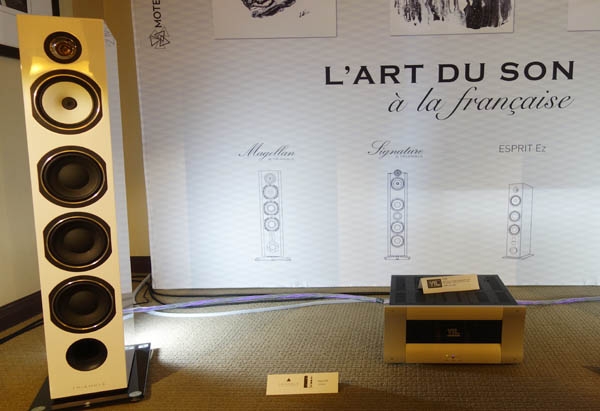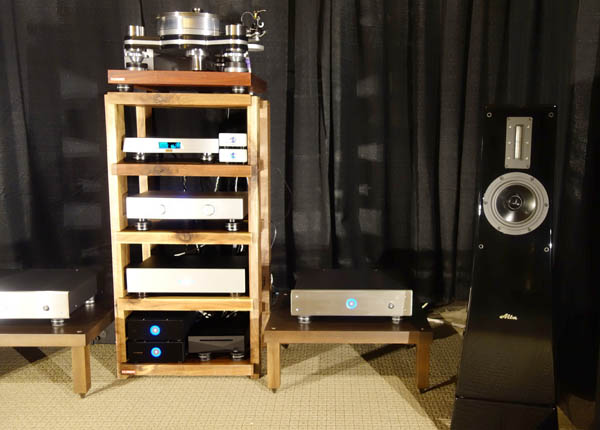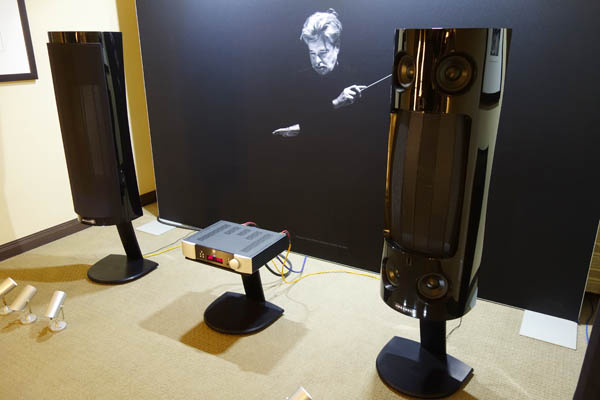| Columns Retired Columns & Blogs |
It is the Wailing Jennys not Jennies
http://www.thewailinjennys.com/
Thanks for the great coverage.

Homesickness was dispelled the moment I heard the system in the first of three rooms sponsored by Motet Distribution of Toronto, this one featuring Triangle Australe speakers ($CAD5500/pair), driven by a VTL S-200 stereo amp ($CAD17,500) and 5.5 preamp ($CAD11,200), with a laptop and an iFi Macro portable DAC/headphone amp ($CAD780) as the source. The system—and the chairs in the room—were set up for very nearfield listening; I'm not a soundstaging junkie. but I couldn't help being wowed, and ultimately entertained, by how far I could hear into a recording of de Falla's Spanish Dances.

I entered the second Motet room just in time to catch the end of an Alison Kraus track—which sounded fine: open and clear, if just a little more upfront than I like. That was followed by a Pat Metheny-Charlie Haden track in which the double bass boomed just a little, although the music was otherwise compelling, especially when Metheny's soloing became more and more chromatic and then seemed to veer beyond the song's home key. The system was a pair of Triangle Magellan Quatour loudspeakers ($CAD26,500/pair) plus a pair of VTL MB-450 III mono amps ($CAD26,500/pair). The line-level preamp was a VTL TL-6.5 II; I did not make note of a phono preamp, but the music source for this room was a lovely late-'80s Roksan Xerxes with a Roksan Tabriz tonearm.

I'll preface the next bit by saying: By mid–late morning on Saturday, the show was really busy, and would remain so for the rest of that day. And there were two things at work against my attempts at thorough reporting: the language barrier, and the fact that a lot of the people running the demonstrations are simply too busy dealing with (potential) paying customers to answer my questions. Some of the reports that follow are a little light on pricing details and, in a couple of cases, specific model numbers/names. If you're an exhibitor and you have correct pricing info for me to add, please get in touch at Adudley@enthusiastnetwork.com. But note: I must ignore requests to expand my posts with data on other items—accessories in particular—that I've otherwise failed to highlight. With respect, I prefer deciding for myself which products did or did not catch my attention.
So then: In the third Motet room, which was co-sponsored by Redleaf Audio Marketing, a Stevie Ray Vaughan track sounded poor: dynamic peaks from the guitar sounded distorted—not the deliberate sort of distortion that comes from the guitar amp and is part and parcel of SRV's (and almost everybody else's) trademark tone—and the electric bass way overcooked, all frowsy and blowsy.
Then came . . . another Stevie Ray track! This one was the dreaded "Tin Pan Alley," which I'm sorry to say has become the national anthem of audio shows, and is thus ruined for me for all time. And this track brought with it even more wildly booming bass and very hot—but not the good kind of hot—soloing. This system used a 55Wpc VTL IT-85 integrated amp ($7300) to drive a pair of stand-mounted Triangle loudspeakers whose model name I didn't get—I even looked on the back of the enclosure!—but whose price, I was assured, was $CAD1900/pair.

Toronto dealer-distributor Audiogen managed to squeeze two very high-pedigree, fine-sounding systems into a single room: no meant feat! The first one I listened to was built around the well-known DeVore Fidelity O/96 loudspeaker ($US12,000/pair), which I and others have praised in our pages. Audiogen drove a pair of O/96s with a Nagra ClassicINT integrated amplifier ($CAD23,750), a 100Wpc solid-state amp that I consider one of the ten best-looking pieces of audio electronics presently being made. The source was a Nagra CDC CD player/preamp ($CAD22,750), also a fine-looking thing. On this system, a CD by German jazzers Julian & Roman Wasserfuhr sounded nimble, colorful, and altogether lovely: The bass was just a little plummier than ideal—possibly a consequence of having the listeners sit so (necessarily) close to the wall behind them.
I was looking forward to seeing John DeVore at the 2018 Montreal Audio Fest—it would have been his first trip there in many a long year—but 2018's Nor'easter IV (ZoSo) kept him at home in Brooklyn.

The other Audiogen system, which actually sounded similar to if somewhat more subtle and delicately drawn than the above, featured the Verity Audio Parsifal Anniversary Edition loudspeaker ($CAD25,000/pair). These were driven by a pair of Wavac MD-805 single-ended monoblocks ($US22,000/pair), each of which uses as its single output device an 805 tube with thoriated-tungsten filaments. The preamp, also from Wavac—the brand founded by the late Nobu Shishido, and a name that, here in the US, has sadly been allowed to fade into undeserved obscurity—was their ATTS passive unit ($US11,000). Equipment stands, including the four-shelf rack ($CAD7800) and single-level amp stand ($US2300) seen here, are from a Quebec-based company called Modulum.

I had heard Alta Audio loudspeakers at other shows—especially the last couple of Capital Audiofests—but I had never before met company head Michael Levy. (Full disclosure: He insisted that I had!) Anyway, we had a very nice visit about the New York audio scene then and now, but just as we set about listening to his Alta Rhea loudspeakers ($US$4495/pair), something in the system emitted an alarming noise in the right channel, and our session was cut short.

The last room I visited before my lunch break was the one sponsored by Ontario-based Muraudio, who made their debut a few years ago at the Montreal show (then called Salon Son et Image), and who specialize in designing and making electrostatic panel loudspeakers with a considerably wider-than-average listening window. Their newest and most affordable speaker, the SP1 ($US14,700/pair), melds a curved electrostatic element with four 6" aluminum-cone bass drivers. Combined with a Simaudio Moon integrated amplifier and Luna Cable Orange speaker cables, the SP1s were very impressive, and made some of the most refined, convincing sounds of the show—and, indeed, in terms of spatial performance, there wasn't a bad seat in the house, and the hand-off between electrostatic and dynamic drivers was undetectable.
Singing voices, on a recording that turned out to be by the Wailin' Jennies—a talented group, in spite of their wince-inducing name, that Janet has seen in concert here in the Albany area—were silky-real, with natural-sounding timbres, good distinctions between head tones and chest tones, and sibilant sounds that were, for once in hi-fi, utterly perfect. On an orchestral number they were similarly natural and convicting: bass notes weren't as powerful as on various large all-dynamic systems, but I was never unsatisfied. The Muraudio room was one that I had to force myself to leave.

It is the Wailing Jennys not Jennies
http://www.thewailinjennys.com/
Thanks for the great coverage.

Sounds as though AD could have stood a couple of vodka and tonics to set him on his feet again, after the show.
Happy horny back toad hunting!

"Nor'easter IV (ZoSo)" -- great line. Thank you Mr. Dudley for all your writing through the years.